Zhang Sanfeng as Founder of Taijiquan
One of the most enduring legends regarding the origins of Taijiquan concerns Zhang Sanfeng, a Taoist immortal who lived on the Wudang Mountains. It is said that he received this wonderful boxing system in a dream from a Taoist God. The dispute between supporters of Zhang Sanfeng as the founder of Taijiquan and dissenters still continues.
Who was Zhang Sanfeng?
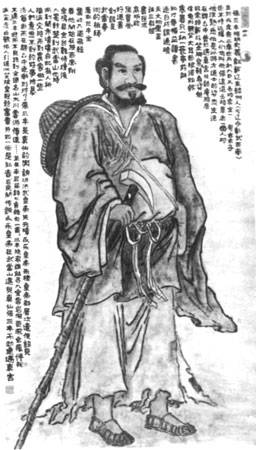
Many historical documents refer to Zhang Sanfeng as a Taoist priest who was proficient in inner alchemy (neidan). However Chinese scholars have yet to reach a satisfactory conclusion regarding this legendary figure. Research indicates that he probably lived between the Yuan and the Ming dynasties (1450 – 1550) and, according to Ming dynasty historical records, he was born in Yizhou city, Liaodong Province in north-east China. After travelling across China he finally settled in Wudang Mountain.
When the first emperor of the Ming dynasty died, his nephew Jianwen, became emperor because his own son had died before him. However, Jianwen’s brother wanted the throne and, because he didn’t know that Jianwen had been killed in battle, he organised several expeditions across China to drive him out. However he couldn’t let it be known that he wanted to drive his own brother out to seize power. He therefore stated that these expeditions were a hunt for the famous Taoist immortal, Zhang Sanfeng. This rumour spread throughout China and contributed to the embellishment of the legendary status of Zhang Sanfeng who now became the most charming and popular immortal since Lu Dongpin. (see Gu Lixing, Paochui, p 10; Ren Jiya. Zhong Daojua shi, p 647).
Zhang Sanfeng’s Writings
According to historical records from the Ming dynasty there were at least two books credited to Zhang Sanfeng:
Jindan Zhizhi – Direct Guide to the Golden Elixir
Jindan Mijue – Secret Formula for the Golden Elixir
These books were not included in 1607 Zhang Guoxiang’s Daozan (collection of Taoist Scriptures). Perhaps they hadn’t been published at that time, or maybe they had been lost. Wang Xiling edited a new collection in 1723 (Qing – Yongzheng era): Sanfeng Zushi Quanji – (Complete Collection of Ancestor-Master Sanfeng). During the Daoguang era (1821-51) Li Xiyue published a new edition (based on Wang Xinling’s) in 8 volumes: “Zhang Sanfeng Xiansheng Quanji – (Complete Collection of Master Zhang Sanfeng.)
Zhang Sanfeng Creator of Boxing Art
The first reference to Zhang Sanfeng as the creator of a martial art is the inscription on Wang Zhengnan’s tomb (Wang Zhengnan Muzhiming) in 1669 (Qing dynasty). Wang Zhengnan (1616-1669) was born in Zhejiang province, Yin County. He taught his art to Huang Baijia, whose father, Huang Zhongxi, composed the inscription.
“Shaolin is famous all over the world for its boxing art but it mainly uses attacking for fighting and the opponent could take advantage of this. There is a so-called neijia that originates from Zhang Sanfeng of the Song dynasty. Sanfeng was a master of inner alchemy on Mount Wudang. Emperor Huizhong asked for Zhang Sanfeng to call on him, but the road was blocked and Zhang couldn’t get through. That night Zhang dreamed of Xuanwu Dadi (A Taoist God – The Great Dark Martial Emperor). Xuanwu showed Zhang the methods of a boxing system. The following day Zhang Sanfeng found that he was able to single-handedly defeat 100 bandits. His art spread across Shaanxi with Wang Zong becoming the most prominent practitioner. Chen Zhoutong of Wenzhou was taught by Wang Zong and he, in turn taught it to others in his town, thereby spreading it through Wenzhou. In the Jiajing era Zhang Songxi was the most famous. (Ma Xianda. Zhongguo Wushu Dacidian p447)
Zhang Sanfeng and Taijiquan
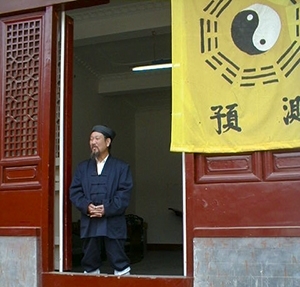
The first reference to Zhang Sanfeng in the Taijiquan world came in the, “Dissertation on Taijiquan” (Taijiquan Lun) created by Wang Zongyue. The book, which contained this document, was the “Manual of Taiji Boxing” (Taiji Quanpu) discovered by Wu Jiyu in 1852. Wu Jiyu gave it to his brother Wu Yuxiang who had originally studied under Yang Luchan and later with Chen Qingpin of Zhaobao town. This book became fundamental in Taiji literature. Every school had carefully handmade copies produced, which were handed down from generation to generation along with their teachings. The book is a collection of theoretical writings on Taijiquan. On of the writings, Taijiquan Jing (The Canon of Taijiquan) carries a note at the end:
“This is the dissertation handed down by the founder Master Zhang Sanfeng of Wudang Mountain, wishing that the people who gain this exceptional ability to obtain longevity don’t use it merely as a technical skill.” (Wang Huipu. Wushi Taijiquan p137)
This note reinforced the belief that Zhang Sanfeng created Taijiquan. The oldest copy available today is a manuscript by Li Yiyu, disciple and heir to Wu Yuxiang, dated 1881. However it does not contain the above reference. On the contrary, Li Yiyu in his “Brief Introduction to Taijiquan” makes the following statement:
“We don’t know who was the creator of Taijiquan, the finest essence of this excellent skill has a detailed explanation in Wang Zongyue’s dissertation. Later (this skill) came to the Chen family of Chenjiagou village, Henan province. They developed it for generation after generation and it became divine and brilliant. A certain Yang from Nanguan fell in love with it and was determined to learn it. Resolute, with strong will he trained for more than ten years obtaining a superb skill. We he returned to his village everybody become his friends. My uncle, Wu Yuxiang saw him perform, liked what he saw and went to learn from him. Since Yang never openly taught others, my uncle could only get a very general view of the art. However he heard that in Yu, province, (Henan), Huaiqing prefecture, Zhaobao City there was another expert in this art called Chen Qingping. A year later my uncle went to Yu province to visit him and he studied there for more than one month, learning this divine art. Now more than 20 years have passed since I began learning this art with my uncle, in the Guichou year of Xian-feng era (1853). He instructed me orally and practically, without sparing energies, prizing my qualities as the worst. After 20 years I didn’t get beyond ‘the hair and the skin’. As my humble opinion, there is beyond, a finer skill to be discovered. I leave this writing to posterity calling it the 5 words formula (Wuzijue)1 in order that we don’t forget what has been learned.”
Xinji year Guanxu era (1881) Middle Autumn, the 6th Heartfelt Li Yiyu
Taijiquan Books During the Republic
Taijiquan became very popular during the years of the Republic. Yang and Wu family, after the downfall of the Imperial system, lost their jobs are trainers of the Imperial guards and bodyguards of the Imperial family. They earned their living by teaching the rich and literati as affluent people used Taijiquan as a keep-fit exercise. It was these educated students that helped them to write the first books on Taijiquan as the Yang and Wu families were almost illiterate. The first book, Taijiquan Xue was written by Sun Lutang in 1919. In his foreword he wrote:
“At the time of Shundi, during the Yuan dynasty, Master Zhang Sanfeng was cultivating the Tao on Wudang Mountain. He was adept in cultivating the inner elixir (xiudan) and trained in the art of boxing. Using postnatal strength far in excess of its normal capabilities one cannot harmonise his Qi in his body, but can damage his elixir, and lose his vital energy. By observing the teachings of the two old classics, using the shape of Master Zhuo’s Taiji diagram, taking the principles of Luo river, the numbers of former and latter Changes, according to the law of nature, he created the Taiji boxing art; clarifying the wonder of body nourishing. This boxing borrows the postnatal shape but doesn’t use postnatal strength. It moves and rests, completely naturally, without rising blood or Qi, with the idea of melting Qi (vital energy) into Shen (Spirit) (lianqi hua shen). It is based on profound meanings such as: one principle (yili) two Qi (erqi), three powers (sancai), four images (si-xiang) five elements (wuxing) six joins (liuhe), seven stars (qixing), eight trigrams (bagua) and nine palaces (jiugong). Wang Zongyue from Shanyou (Shanxi) discussed the subtle and profound essence of Taiji boxing art in great detail. Many different styles sprung up, each one following its own ideas with different postures and movements. Then, during Dao and Xian era (1821-1862) the Qing dynasty, Master Wu Yuxiang of Guangping heard that in Huaiqing prefecture Zhaobao town, Master Chen Qingping was also skilled in this art. Despite the large distance, he travelled to visit Master Chen and studied with him, acquiring his principles.” (Sun Lutang, Taijiquan xue, pp 1,2,3).
In 1921 Xu Longhou published the first book on Yang Style Taijiquan – Taiji Quanshi Tujie (Taijiquan Movements Illustrated). This book states that Taijiquan comes from Zhang Sanfeng who taught Wang Zongyue from Xi’an Shaanxi province, who taught Jiang Fa of Henan, who taught Chen Changxing of Chenjiagou. Almost all Taijiquan books published during the Republic of China, except those by the Chen family, report this version.
Xu’s Version
Zhang Sanfeng Wangzongyue Jiang Fa Chen Changxing
(Hubei Wudang) (Shaanxi Xi’an) (Henan) (Henan Chenjiagou)
The first documented investigation on Taijiquan’s version.
At the end of the 20’s, Tang Hao (1897-1959), who was the director of the Central National Art Institute (Zhongyang Guoshuguan) Publishing Office (Bianshenchu), undertook research and investigation on Chinese Martial Arts history. He collected and examined classical boxing manuals and went several times to famous sites of martial arts, such as the Shaolin Temple, Wudang Mountain and Chenjiagou village. In 1930 he published the results of his studies in the book, “Shaolin Wudang Kao”, (Investigation on Shaolin and Wudang). He stated that on Wudang Mountain there were no boxing manuals (Wudang Qu Quanlu) and Taijiquan was not created by Zhang Sanfeng, but probably by Chen Wangting of Chenjiagou village in the 17th Century. His thesis has been widely accepted by Wushu historians in modern China but the debate on Zhang Sanfeng still continues.
The Situation Today
In the past the Yang and Sun families supported the view of Zhang Sanfeng as the creator of their boxing system, see:
Sun Lutang’s Taijiquan Xue (1920)
Yang Chengfu’s Taijiquan Shiyongfa (1931)
Ma Yueh Liang’s Wushu Taijiquan (1935)
Today the most outstanding representatives of these famous Taijiquan families credit Zhang Sanfeng as the father or their martial art. Some of them are quite evasive regarding Taijiquan’s origin. Yang Zhenduo and Yang Zhenji (son’s of Yang Chengfu) talk only of their own family history. However, even today. the name of Zhang Sanfeng does still appear. In recent years we have seen a proliferation of books and research on Zhang Sanfeng and many formerly unknown Wushu styles claim a connection with Zhang Sanfeng.
Taijiquan Styles Derivation
Among the recognised styles of Taijiquan that we have today, Yang and Wu are derived from the Chen, Wu and Li are derived from the Yang; Sun has derived from the Wu and Chang is derived from Wu.
Map of Taijiquan Styles
Zhaobao – Chen – Yang – Wu – Chang (He Style) – Wu (Hao) – Li – Sun
The Dispute Between Zhaobao and Chenjiagou
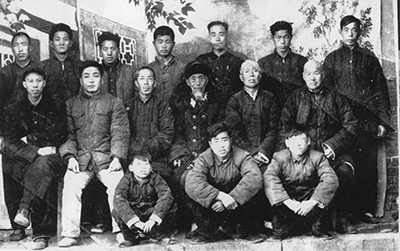
All the recognised Taijiquan schools are derived, directly or indirectly, from Chen style Taijiquan but there is a dispute going on between Chenjiagou and Zhaobao. Chen family recognise Zhaobao style as a close cousin (the styles are similar and the two villages are very close to each other). According to Chen people Chen Qingping (1795-1868), teacher of Wu Yuxiang, 15th generation of the Chen family, married a woman from Zhaobao and moved there, bringing his Taijiquan with him. Zhaobao people say that their Taijiquan comes from Zhang Sanfeng, who taught Wang Zongyue, who taught Jiang Fa, who was from Zhaobao. However, even among Zhaobao people there are large contradictions. In a book that was published in 1991 Liu Huizhi, 14th generation of Zhaobao styles, doesn’t even mention the Chen family in his tree depicting the transmission of Taijiquan. He also doesn’t mention Yang Luchan, one of the most outstanding figures in the world of Taijiquan, as a result of bringing it to Beijing where he taught Prince Duan family. Here is the first part of his offspring line:
Zhaobao Version 1.
Zhang Sanfeng Wang Zhongyue Jiang Fa Xing Xihuai
Zhang Chuchen Chen Jingbo Zhang Zhongyu Zhang Yan
Chen Qingping
In October of the same year Liu Huizhi, together with Qu Malong and Li Wanbin, wrote an article on Wudang Magazine (1992.3) and gave yet another offspring line, which this time included the Chen family.
Zhaobao Version 2.
Zhang Sanfeng Wang Zhongyue Jiang Fa Xing Xihuai Chen Wangting
Wang Haizhou, chief coach of Zhaobao Taijiquan, in an article which appeared in the first issue of the magazine, Zhonguo Taijiquan (1993) gives the following version (its like the first of Liu Huizhi but without Zhang Sanfeng).
Zhaobao Version 3.
Wang Zhongyue Jiang Fa Xing Xihuai Zhang Chuchen
Chen Jingbo Zhang Zhongyu Zhang Yan Chen Qingping
Remarks
In the old collections of writings credited to Zhang Sanfeng as 1723 Wang Xiling’s Sanfeng Quanshu there is no mention of Zhang Sanfeng as a boxer or founder of a martial art. (Gu Liuxing, op. Cit., p.9)
Comparing the Xu’s version and those of Zhaobao we can find an obvious contradiction: Xu says that Jiang Fa taught Changxing (1771-1853) and Zhaobao people (version 2) say he taught Chen Wangting (1600-1680); between these two there are five generations, more than 150 years!
Wang Zongyue was from Shanxi not from Shaanxi (the names are similar but they are two different provinces) and he lived in the 18th century. In his book “Yingfu Qiangpu” it is recorded that he was in Henan province from at least 1792, teaching first in Luoyang and then, in 1795, in Kaifeng. According to Gu Liuxing the philosophical view of Wang Zong Yue’s Taijiquan Lun was clearly influenced by Zhouzi Quanshu (Complete Book of Master Zhou) a work issued in 1753. This is further proof that Wang Zongyue lived in the late 18th century and learned from Chenjiagou people (see Gu Liuxin, pp300, 322, 323). So couldn’t have taught Jiang Fa who lived in the 16th century and was a contemporary of Chen Wangting.
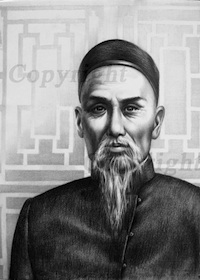
Yang Luchan wasn’t the first outsider to learn from the Chen family. Before him Chang Naizhuo (1724-1783) from Changcun, Sishui district, Henan province went to Chenjiagou and later created his own martial art (see Ma Xianda, op.cit., p459). It is now possible to verify this story from Chang Naizhou’s book, “Changshi Wuji Shu.” (Chang Family’s Martial Art Book) and with Chen’s family records, (Chen Xin, Chenshi Taijiquan Tushuo, p 426). This is proof that the Chen family knew Taijiquan before Chen Changxing, who couldn’t have been the first member of the Chen family to learn Taijiquan, as some claims make.
Cheng Jinbo, listed as the 6th generation of Zhaobao Taijiquan, was a member of Chen family, a well-known Taijiquan expert who worked in Shandong province police and who became famous for his martial skill (Chen Xin, op. Cit., p 426).
If we look at Huang Zongxi’s inscription we can’t find any Jiang Fa in his Neijiaquan offspring line. There is no Wang Zongyue from Shanxi but a certain Wang Zong from Shaanxi.
We can still find today the Neijiaquan in Sichuan province, Nanchong district, it’s called Wudang Songxipa Neijiaquan. The teaching tree of the style is the same as the Huang Zongxi version and the style looks quite different from Taijiquan in both principle and technique.
Liu Huizhi in his article claims, that according to Du Yuanhua’s Taijiquan Zhenzong, Jiang Fa was born in 1574, making him nearly 30 years older than Chen Wangting. This supports his version of Jiang Fa as the teacher of Chen Wangting. Another article by Wu Wenhan about Zhaobao Taijiquan appeared on Wudang magazine 1992.2 says Jiang Fa was born in 1633 and died in 1714). The majority of Wushu historians consider Jiang Fa younger than Chen Wangting.
Conclusion
On Zhang Sanfeng as the Creator of Taijiquan
In old China it was very common to take a legendary figure as founder master (Zushi) of a martial art. We can find Buddhist and Taoist monks, heroes and generals, emperors, Gods etc. If we want to look only at Taoist founders we can find many examples among internal and external styles:
Meihuaquan has Qiu Chuji (founder master of Longmenpai, an important Taoist sect).
Baijiquan has an unknown wondering Taoist
Baguazhang has a Taoist master of Jiuhuashan, Bi Haixia (others say Bi Dengxia)
Tongbeiquan has a Taoist called Donglingzo (or Baiyuan – white monkey).
Liuhebafaquan, Chen Tuan.
In the writings credited to Zhang Sanfeng and compiled by the Taoists Wang Xiling 1723 and Li Xiyue (1820’s) of Qing dynasty there are no traces of martial art and Taijiquan was already known outside Chenjiagou. Moreover, in the Taijiquan world it is not only Zhang Sanfeng who has been credited as the founder of Taijiquan. In Xu Longou’s book for example, there is a long list of Taijiquan ancestors:
Xu Xuanping of Tang dynasty
Li Daozi of Tang dynasty
Han Gongyue and Cheng family
Yin Liheng
Zhang Sanfeng
Yun Haixian in an article, which appeared in Wudang magazine (1992.4), says, “Taijiquan started from Laozi.” Wang Lanting, disciple of Yang Luchan stated:
“Taijiquan started with Xuanyuan Huangdi. Huangdi was a son of the Shaodian clan, his family name being Gongsun, his capital Youxiong. So they were also called Youxiong clan. This is why Taijiquan is also called Bamian Youxiongquan. Taijiquan started with Xuanyuan Huangdi who saw a snake and a crane fighting and so he understood the mechanism of human fighting.” (Wudang, 1994.5 p22).
We can see that Zhang Sanfeng is just the most popular of many legendary versions regarding Taijiquan’s creation. Maybe this is because Zhang Sanfeng was one of the most popular figures during the late Ming dynasty. He overcame even Lu Dongbin as the most popular immortal during Ming and Qing periods. He was honoured as the patron of martial arts as well as sexual yoga and he was associated, in the popular religion, to the God of Wealth (Santangelo, Soria Del Pensiero Cinese, p 81). He was considered founder not only of Taijiquan but also of Neijiaquan, Liuluquan, Wudang Taiyi Shenjianmen Quangong, Baguazhang (1932 Jiang Rongqiao), Wudangjian (Wudangquan Zhi Yanjiu pp 178 –197).
Chenjiagou and Zhaobao Dispute
Somebody claims that Chen family concealed Zhang Sanfeng in order to put itself as the creators of Taijiquan, to become more famous. I think that this is not a realistic viewpoint. In Chinese martial arts it is never the case that somebody disowns his ancestor master just in order to promote his own name. It is always the other way round with people trying to establish a link with a legendary figure to add weight to their system. If the Chen family was aware of Zhang Sanfeng there would have been no reason or benefit for them to conceal their links. To be the heir to an older tradition is much more honorable in China than being the founder of a new movement. Moreover the Chen family didn’t suggest the thesis of Chen Wangting as creator of Taijiquan, but by a certain Tang Hao, who was not only not a member of the Chen family, but not even a practitioner of Taijiquan. He practised Liuhequan. It is really strange that people from Zhaobao and (though increasingly less) other Taijiquan stylists still try to discredit the value of Chen family’s Taijiquan. It’s known that all the most popular Taijiquan styles (Yang, Wu, Wu) are derived from Chen’s. If they claim they are from Zhang Sanfeng, and also Zhaobao say that they are from Zhang Sanfeng, why are Zhaobao and Chen style so similar, when the others are so different, from these two styles, but similar to Yang style?
The version from the Republican period is completely overturned as it proved that Jiang Fa couldn’t be the teacher of Chen Changxing. The same is true of the Zhaobao version, Wang Zongyue couldn’t be the teacher of Jiang Fa and, even if we suppose that Wang Zongyue lived in the 16th century and not in the 18th, he couldn’t be disciple of Zhang Sanfeng who died in the middle of 15th century.
On Taijiquan’s Origin
Many Chinese historians, from the 1920’s onwards, point out that there is no documented evidence to support the Zhang Sanfeng story. Nevertheless, even today this legend is so strong that many people still believe it and search for documents to prove it.
There is still a lot to find out about Taijiquan’s origins and the theses of Tang Hao and Gu Liuxin are not bibles. Chen family itself believed that Chen Bu created its Taijiquan, nine generations before Chen Wangting.
The role of Jiang Fa is still to be clarified. His name appears in every Taijiquan School and Taijiquan book. Du Yuanhua in his Taijiquan Zhengzong claims he was born in 1574 and lived in Xiaoliucun, a village in Wen district, Huaiqing prefecture. When he was 22 he studied under Wang Zongyue of Shanxi Taiyuan Taiguxian. After he should have taught his art in Zhaobao and Chenjiagou. (Qi Jianhai, Jiang Fa Chuanquan Zhi Shuo, “Wulin”, p 27). If he was really born in 1574 he was much younger than Chen Wangting who was born in 1600. Others say he was born in 1633 and died 1714, lived in Xiaotiancun, and in 1649, went to Shanxi, Yangchengxian Qiligang Xiaowangzhuang to study with Wang Zongyue. (Wu Wenhan. Chushi Zhaobao Taijiquan, “Wudang”, 1992.2, p 30). So the first problems is to clarify the lifetime of these figures.
Investigating Chinese martial arts is a big task. There is a lack of original documents. We have to see more serious research and studies. Unfortunately quite often in China research is not always done scientifically and is usually done selectively, (see Wundangquan Zhi Yanjiu) to discredit a rival school than to clarify the facts.
Notes
This was just the foreword to “the 5 words formula”, a detailed explanation of Taijiquan principles that became a known classic in Taijiquan history.
It was the National Institute for Martial Arts during the Republic.
Chen Tuan (?-989) Zi Tunan, Hao Fuyaozi was born in Bozhou Zhenyuan (today Anhuisheng Boxian). He was a Taoist priest during the Five dynasties beginning with Song. He settled in Wudangshan for more than 20 years, studied breathing and other aesthetic techniques. He then moved to Huanshan, wrote books on Daoyin, Yangqi and Inner Alchemy (neidan) and the famous Wujitu and Xiantiantu that greatly influenced Zhou Dunyi in his metaphysical speculations (Hao Xinlian, p567). He is also sometimes considered of the same sect as Zhang Sanfeng.
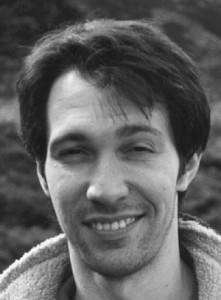
Author: Fabio Smolari
Fabio Smolari graduated in Chinese Language and Literature at the University of Venice and started learning martial arts at the age of 10. Since 1995 he studied Traditional Chen Style Taijiquan with Francesco Fedeli and his teacher master CHEN Xiaowang, 19the standing bearer of Chenjiagou’s Chen family.
Images: Fabio Smolari, Matthias Wagner and Taiji Europa
